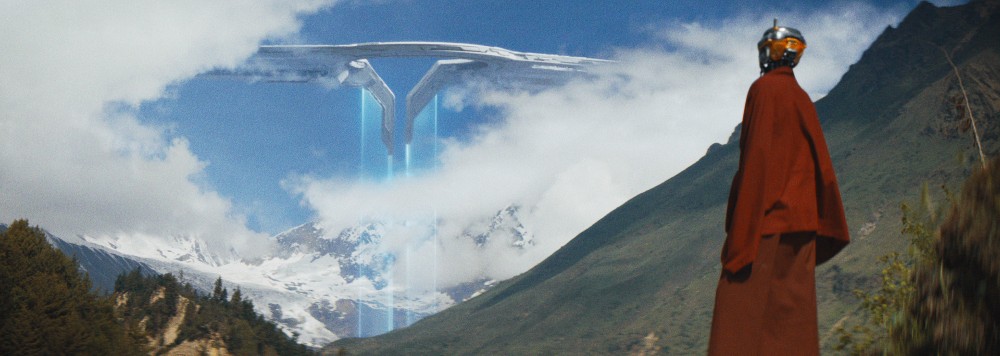
When Director Gareth Edwards (Rogue One: A Star Wars Story) decided to tackle an original science fiction concept in The Creator, he approached it in quite a unique manner, filming on actual locations in Thailand, and then adding all the futuristic elements in post using visual effects. In order to do so, he returned to Industrial Light and Magic (ILM), who had previously worked on his Star Wars movie, and commissioned them to work fully from the footage shot on location with the actors.
The Creator revolves around military man Joshua Taylor (John David Washington), who has been living undercover in New Asia with his wife Maya (Gemma Chan) amidst a war between the Americans and the growing A.I. population that’s been held responsible for a nuclear explosion in Los Angeles. Five years after his operation goes South, Taylor is called back to Asia to seek out the enigmatic “Nirmata,” a being responsible for creating a new form of A.I. that can defeat the Americans’ primary weapon, the NOMAD flying war machine. That A.I. comes in the form of a six-year-old girl (Madeleine Yuna Voyles), who Taylor is sent to kill but whom he finds himself having to protect from both sides of the war.
To conceive the necessary visual effects for robots, humanoid “Simulants,” futuristic location builds, and NOMAD, Edwards brought on Jay Cooper as ILM’s VFX Supervisor and Andrew Roberts as the film’s on-set VFX Supervisor, both of whom Below the Line spoke to before the movie’s release. Since the resulting conversation did delve very much into the film’s last act, it’s probably best to read the below with some heavy SPOILER WARNINGS in place.

Below the Line: Fantastic film, and you’ve done some fantastic work on it, where it was difficult to tell where the real-world environments ended and visual effects began. They blended so well.
Jay Cooper: That’s great. Gareth will love hearing that. It’s great feedback.
BTL: Are you both at ILM?
Andrew Roberts: Jay longer than me. I’ve been at ILM for about three years now.
Cooper: I have been there slightly longer. I think I’m coming up to my 25th anniversary. I started when I was eight.
BTL: How were you brought on? I assume Julian Levi, the main VFX supe, broughtn you on? ILM did the majority of the VFX shots for this film, right?
Cooper: ILM, as a company, has a long, or at least a great relationship with Gareth, having worked on Rogue One. He has a long-standing relationship with John Knoll, who’s our creative director in San Francisco, and when Gareth was trying to get this off the ground, he approached John about doing a test, where he could help do some visual effects shots that would help loosen the purse strings and get the movie greenlit. We started with that about three-plus years ago. That was about 50 shots we did based on a travel… I want to say it’s like a travel film that Gareth put together, and it was very, very documentarian, very much long takes of observations of different environments. We started with that. That got the movie going, and then we partnered with Gareth, that was when I joined, shortly after he got the green light.
Part of partnering with him, sort of the charge was I was how do we approach this project in a way where we can get amazing visuals and amazing production value with a smaller budget. Not to say that it’s the tiny budget, because it’s not a small budget by visual FX standards, it’s pretty robust. The idea is that he wanted so much scope and so much scale, that he was really asking us, “Where can I cheat? What are the things that I could do to expand out the production value while keeping the budget down?” We looked at that with him, and we came to an arrangement that we would try to work in a way that was more efficient, and that he would delay some of the choices that… these are actually his ideas that he would do some of the design after he had a cut, so he wouldn’t have to spend money building things that didn’t show up in the cut. And then, we would basically keep on building up his movie until we ran out of money effectively.
To answer your second question, ILM did more than half of the work, but there were another 10 vendors or seven vendors that also worked on the movie. ILM is pretty much the chief architect of all the design. We designed the Simulants, and the robots and a lot of the ships and the NOMAD and things like that. We shared a lot of our assets with other vendors, but we’re not the only vendor on the movie.
BTL: Did [Production Designer] James Clyne work at ILM also?
Cooper: At the time, he had sort of a hybrid role. He’s an art director at ILM, and then he graduated to production designer and he worked for the movie directly as a production designer, but he still had an office at ILM. It was that close collaboration where we were able to work with him on a daily basis, where we were going back and forth with him for design and for improving our look along the way. He would do a design, we’d sort of put it together in 3D, and we would do a little bit more design going back and forth. We did that innumerable times when it came to robots or assets or environments, all those sorts of things.
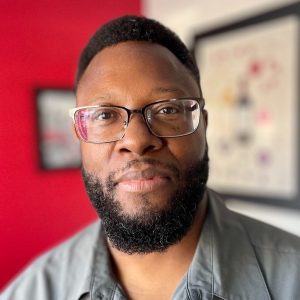
BTL: Andrew, you were the on-set VFX supe, so I assume you were the one travelling to all these places with Gareth and the production team. How were you working with them on set to make sure they got everything they needed for ILM to continue its work?
Roberts: You’re right. It was minimal green screen. There were a couple of cases where we needed to make sure that we would be able to correctly integrate characters, say if Howell was hanging out of the helicopter, and her hair is blowing against the night sky, that it would make sense for us to put up blue. Gareth understood that having a deep background in visual effects.
Some of the things that I would work out would be capturing the lighting environments, the different lighting conditions, taking measurements and scans, overseeing the scans of each of the characters, because we knew that we would require digital doubles, in certain cases, for Joshua and Alfie and some of the other characters. And then, being present on set every day with Gareth as a creative partner to understand how he would like to execute something, and what would be the best way for us to do that and to support him with the visual effects.
Some days we were in locations, for maybe a day or two, and for others, it was longer. It might be, say, a couple of weeks, when we were at the Mon Bridge location for the tank battle. It was five different locations surrounding that bridge, and the floating villages on either side of that bridge. So, [it was] really just making sure that I was capturing the environment with my drone, as well as some cameras to make sure that the team back in SF had all the information they needed. It was a privilege to be able to do some second unit photography for Gareth for when the military are taking off and landing, so working with the drone team to be able to get the terrain.
Gareth was very thoughtful about, for instance, if there’s going to be a monitor insert. When Joshua is in the AI Lab, and he pans in on the screen, and he thinks he sees Maya, I was working with the team to make sure that we capture those scenes of the person that sort of looked like her and then directing people moving around the different lab or when the various soldiers are storming the AI Lab. It was a small, nimble team, where we were all hands on deck and happy to help out in additional ways along with making sure we captured the info for visual effects to do their work.
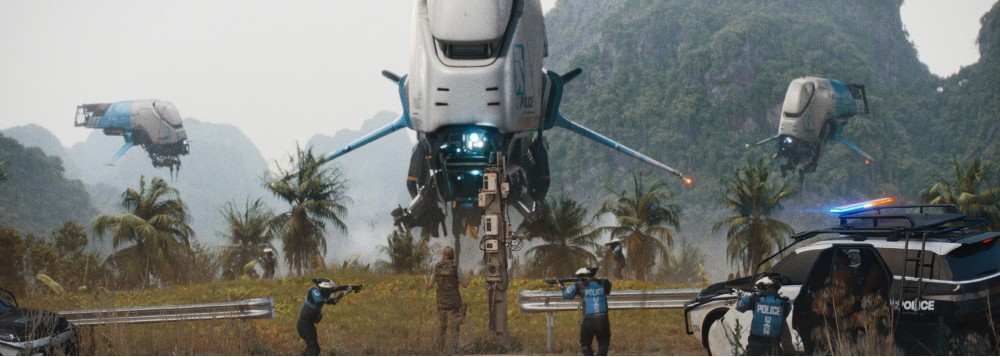
BTL: Jay, you mentioned a couple other vendors on the show, so were you capturing what was needed and passing it onto them? Did everything go through ILM before going to others?
Cooper: Some of the vendors were directly reporting to Gareth. Others were working for us, or were working underneath us, so to speak. It’s a pretty common thing in visual effects for us to share assets, whether there are robots or rigs or whatever, and then, obviously, we had a style guide for what things should look like as well.
BTL: Were the Simulants handled by one specific vendor as well?
Cooper: That was us. We did a bunch of them, hundreds of them, actually. Finding a design for Alfie and Harun [Ken Watanabe’s character], and Don and a few others, and then working out how to put that thing together or her together, figuring out which portions we would turn into negative space, which portions would be the dividing line between her neck and her mechanics and how that’s all going to work together. Coming up with the animation of her interior drums and finding a visual vocabulary of how that would correspond to her emotion and how she was acting.
BTL: For Madeleine and Ken Watanabe who had the neck pieces, I’m not sure what you were calling it…
Cooper: The tech.
BTL: What was involved with them on set to represent what would be replaced with visual effects? Was that something you could do in VFX without having green screen on the actors?
Roberts: We kept it quite minimal. There were just a few dots that we would place on certain parts of their face where it was relatively rigid, so by the temple and in front of the ear, and one on the chin and the tip of the nose, so that we were able to track head movement, and there wasn’t too much sliding when they were emoting. That became the basis for our layout suit Tim Dobbert and the rest of his team to be able to track them, and then be able to add that tech onto the characters.
Of course, we did do LiDAR. We did full scans of the characters, so having the filmed material along with that tracking information, and then having the digital representation of them. It was that combination, and then a lot of hard work by the VFX team that allowed us to integrate their tech and really make it seamless.
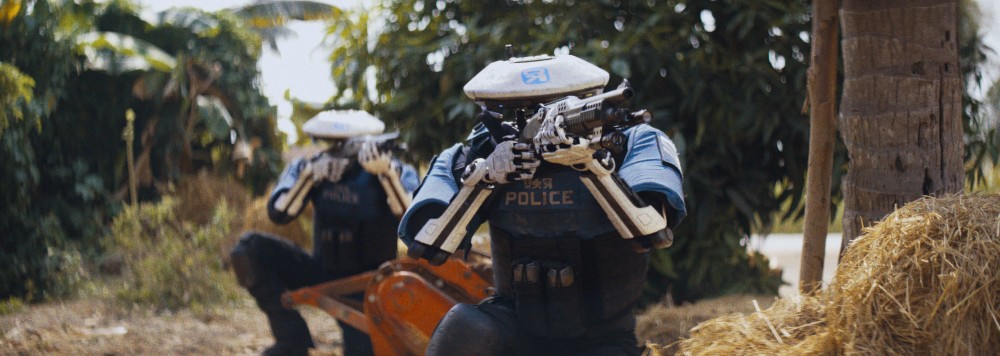
BTL: I know you guys have stages back at ILM, so were there scenes that were all VFX-driven that you were able to shoot extras or stuntmen there, where it wasn’t reliant on the location?
Cooper: That’s a great question there. We had a couple of different ones actually. First, we had our Stagecraft shoot in London, so we did two sequences with the Stagecraft set-up – the airlock and the biosphere. We built environments of both of those, and those were rendered in Helios on the stage. And then, some of those we supplemented after the fact with additional falling debris in the case of the biosphere, and then in the case of the airlock, the stage for. That environment is kind of a drum, so we didn’t have a space large enough to take away the stage floor.
Those were supplemented in post, and then, as well, adding the airlock robot. And then on the stage in San Francisco, we hosted Gareth for what we call a virtual camera session, or V-cam setup, where we had the NOMAD, and we had a proxy version of it with the animation beats we had to accomplish. He got to actually lens, using some tools that we’ve created, where he could find camera positions and do very dynamic camera moves, and then we used those as the basis for the virtual cinematography that appears in the third act. He was with us for a couple of days doing the V-cam setup, and then probably a week on the Stagecraft stage.
BTL: Were there stuntmen or women who were involved in those shoots that you were able to use for that animation?
Cooper: For sure. When [Joshua] gets strung up and gets manipulated by that robot, he’s on a big pick rig from the stunt team, and he’s getting flown around that environment. That was used. We also had a digital double, that we used for a lot of shots as well, when he’s not looking at us. Because it’s in space, every time you see Joshua’s helmet, that’s a rendered element, because we had to render the reflections into it.
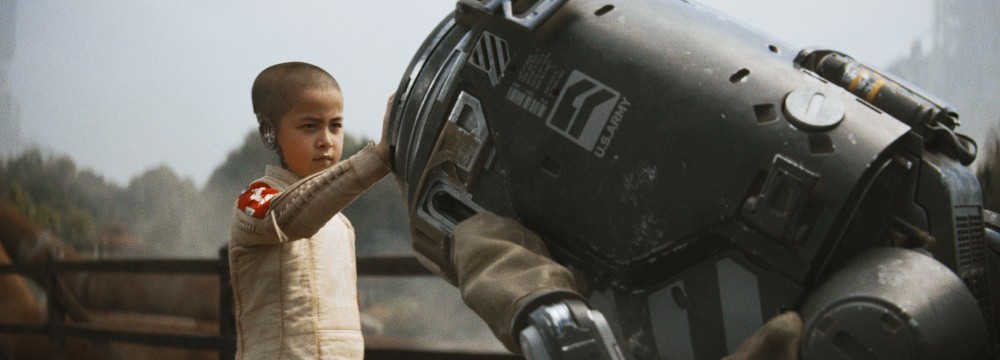
BTL: How did Madeleine do with all this tech stuff? She’s young and new to making movies, and there’s so much that has to be added later. How did she deal with that aspect of it?
Roberts: I mean, it was remarkable. She’s truly a talent. Maybe perhaps it’s her age where she was able to make-believe, but I think a large part of it was Gareth’s approach where we weren’t surrounded by green screen and lots of imposing elements. When we’re in the floating village, she is in a floating village. There are people wandering around, she’s interacting with other children, knowing that a lot of these elements are going to be added afterwards. There wasn’t anything that she needed to interact with that wasn’t physically there in some way.
For instance, for the tank battle, when we’re on the bridge, we had a stunt person there, he was dressed in black, and we had little markers tracking his limbs, and then we attached a five-foot pole to his back, so that he in total was around 10 feet tall. That would allow Gareth to frame appropriately and know that final element is going to be there. And then, we had a little pad that we attached to the end of the stick so that when he kneels and bows down, that she has something to interact with. She had something that she can place her palm on.
She’s an incredible actor, who was able to just get into the spirit of being this synthetic being. Gareth did a lot of work to just really make it about the people, so her relationship with Joshua, or when she’s with Kami, Drew’s girlfriend, and their conversation, whether it’s at his apartment or within Drew’s workshop, there were always things around there for her to be able to interact with, then we added the additional elements afterwards.
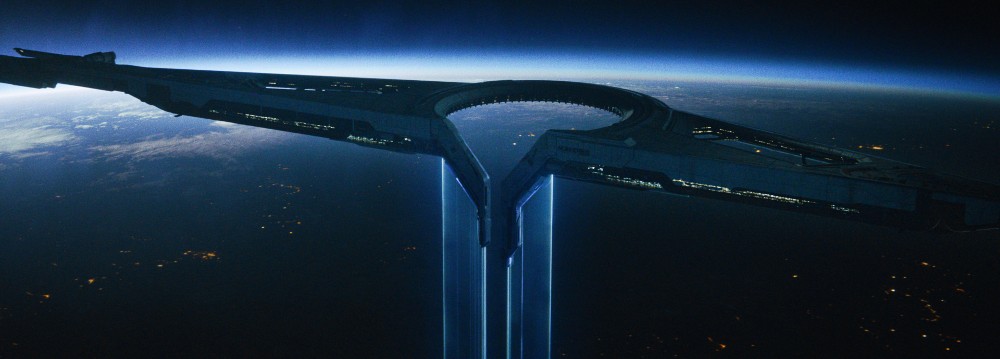
BTL: On set, when the NOMAD appears and isn’t actually there, how did Gareth convey that to the actors, so they could understand how large this thing is that’s hovering in the air. Did he just have a picture to show them and say, “It looks like this?”
Roberts: For instance, when everyone’s rejoicing, the protesters who are within the structure. There’s an overpass, and then there’s a frame where they’re looking up and they’re seeing parts of NOMAD rain down. Gareth explained to them, “Okay, look up there. There’s this huge thing falling down.” That sort of plays, because it’s hundreds of miles away — it’s sort of a great distance. He would insure that everyone’s eyeline is correct. They’re all looking up and reacting to this thing far away. That was one case where there was something.
Cooper: It’s pretty forgiving, luckily, for sure.
BTL: We do need to wrap-up, but Andrew, I know you had a similar function on Martin Scorsese’s Killers of the Flower Moon. Unlike The Creator, that movie does not seem like it has a ton of visual effects. What was involved on your end? Adding oil rigs, cleaning things up for period accuracy?
Roberts: That’s right. I was supporting the overall supervisor, Pablo Helman, and that was for the aerial oil rig shot where you see a number of them in the distance, and then there were some other sequences where there’s a little bit of a battle. It was more of a traditional setup, if we needed to have blue screen, but a lot of the same sort of tools for measurements and capturing lighting information and scanning, so the team has the best tools to get the job done, but it was a cool experience.
Roberts: Is there a NOMAD you’re adding to that one also? [laughter]
The Creator is still playing in theaters nationwide.
You can watch a behind-the-scenes reel about ILM’s work on the film below.





